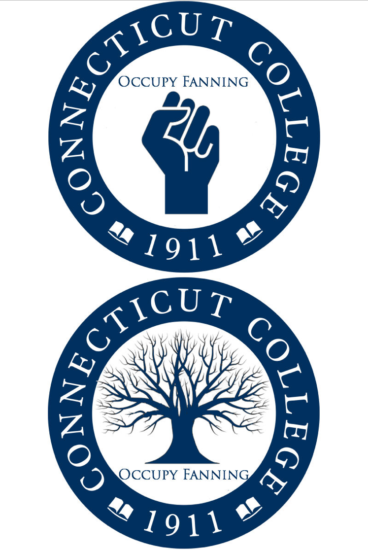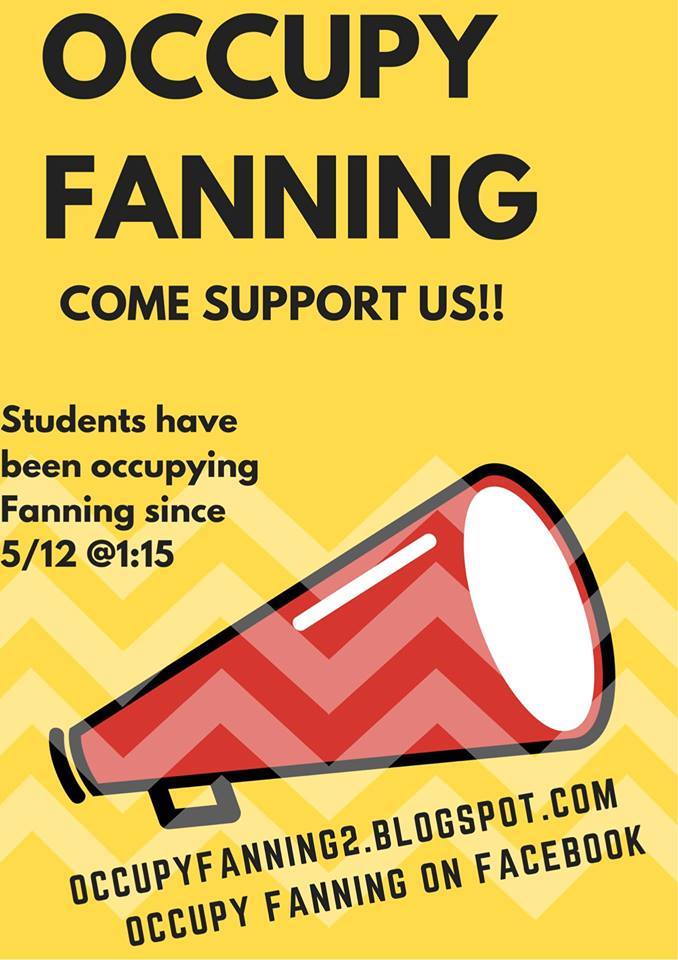On May 12, 2016, amidst the excitement and angst of final exams, Connecticut College student protesters occupied the administrative offices of Fanning, demanding accountability for administrative incompetence. Students would continue to occupy the building until the school year came to an end.
This occupation was sparked by the administration’s response to another instance of student activism: the posting of flyers by Connecticut College Students in Solidarity with Palestine (CSSP) in dorms. These flyers drew attention to the injustice of Israeli occupation of Palestine and detailed the displacement of Palestinian people and unlawful demolition of their homes, citing facts and statistics from Israeli peace organizations.
It didn’t take long for the administration to respond to the poster protest. That evening, Professor Canton, then interim Dean of Institutional Equity and Inclusion, sent out an email informiyng the student body both that a bias incident report had been filed around the flyer protest, and that the administration would be investigating the incident immediately.
Students found this response inappropriate and biased towards the CSSP at best, as the posting of flyers had complied with school rules regarding student protests and no violations of the honor code had been made. This response was also received as proof of the administration’s negligence toward previous complaints of bias incidents, which apparently did not merit campus-wide communications, nor administrative action.
Students decided to occupy Fanning to demand accountability for the unequal treatment of bias incidents. As the protest gained momentum, additional grievances regarding administrative failures began to surface. I contacted the authors of the Occupy Fanning blog site to gain a better perspective on the protest’s evolution. The protest began, they said, “with a small group protesting the interim Dean of Institutional Equity and Inclusion’s all campus email that students targeted experienced as punitive and threatening. However quickly (within hours of the occupation) those students were joined by many other constituencies who had experienced incompetent handling of bias cases and other administrative failures.”
Mishandling of and non-response to bias incidents involving homophobia, racism, and sexual harassment began to become unearthed. One can find reports of these incidents and their administrative responses detailed in full on the Occupy Fanning blog, which has accrued no less than 24,000 views. The blog’s first post, “Why We’re Here,” details the motivations for the occupation. Upon occupying Fanning and conversing circularly with faculty, students “came to realize that the problems at the College are deeper than [they] previously understood. Specifically, through this process, they came to realize that the President has cultivated an environment of control, surveillance, job exploitation, and repression that inhibits the work of the College.”
One instance provided in support of this is the filtering of mass communications through the Communications Office, which the movement cites as amounting to censorship and a serious impairment of the ability of individual departments and offices to do their jobs. The other is a lack of agency and autonomy on the part of the Office of Institutional Equity and Inclusion.

Photo courtesy http://occupyfanning2.blogspot.com
With this target of broader institutional reform, the Occupy movement began to highlight additional structural grievances. Among these was the absence of institutional support for interdisciplinary programs, faculty of color, and Africana Studies. Concerns around the Africana Studies Program included the “diversity tax” used previously to fund the program, and, in response to upset faculty and students alike over this tax, an unsustainable funding “gift” from the President to tide the program over for the next 2 years. This lack of institutional support, the Occupy Blog states, “reflects a pattern of bias and exploitation in the name of the same “diversity” from which the College profits, basically through uncompensated and even disparaged labor….All at the same time that the college sells its credentials of “full participation” and “inclusion” to gain new clients.”
I questioned the Occupy blog authors about their perception of the administration’s overall response to the movement and the grievances raised concerning institutional reform. Their response:
“We know that our movement received broad support from alumni, members of the community, faculty, staff, students, and people from other universities. The administration seemed to be very concerned with putting out the fire before graduation but did not address any of the real concerns we raised.”
I also spoke with D. Afeni McNeely Cobham, Associate Dean of Institutional Equity and Inclusion, who was present for much of the occupation. On the issue of the unequal treatment of bias incidents, she said,
“The senior administration felt that there was something that needed to be said, campus-wide, about tone and culture. There may be issues on campus which become so pervasive…that it requires someone to open up the dialogue and say, “We’re aware of this as an administration”; we want people to know–our stakeholders who watch the emails outside of campus and the ones who are here, a part of the institution–that this is not being swept under the table.”
When asked about the administration’s response to specific concerns about institutional support for interdisciplinary programs, and the future in store for Africana Studies after the expiration of its 2-year funding project, McNeely Cobham expressed confidence in the ability of David Canton, now Director of the Africana Studies Program, to anchor the program. “His knowledge [as a former administrator], as well as the relationships he has been able to establish with the President and others,” she said, “will help him and other faculty in Africana Studies to be in conversation about a model for sustainable funding and support for that program…He has the ability to negotiate and work in partnership with other offices to strengthen the program through financial resources and student involvement.”









